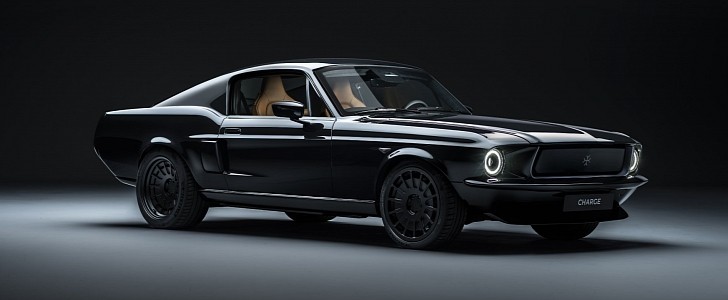Charge is a British startup that dreamed of recreating an iconic car like the 1967 Mustang Fastback but with an electric powertrain and modern-era features. They introduced the project in November 2018 and offered a few updates over time. Now, they unveiled the production version of the car, which apart from the price tag and some minor details, looks just like the prototype from three years ago.
Electric conversions are nothing new and we’ve seen a lot of projects to replace old powertrains with electric motors on some electric beautiful classic cars. Some say it’s a sacrilege, while others shrug and move on, but the trend is here to stay and will only intensify in the future. But there’s another trend coming and this is building entire electric vehicles from the ground up and putting classic car shells on top of them, making them electric modern-classics.
Charge’s take on the ’67 Mustang uses an officially licensed shell placed on top of an electric platform that the company developed in partnership with Arrival. Going official allowed Charge to preserve the classic design and styling of the pony car, while also pioneering in terms of modern features. Compared to the prototype revealed in 2018, the new electric Mustang by Charge has a sleeker front part, with different LED headlights. The wheels are also different this time, possibly as a result of aerodynamic optimization.
Charge reveals for the first time the finished interior, where we can see there is not much resemblance with the classic Mustang. As expected from a modern vehicle, there’s a digital instrument cluster and a big infotainment screen that rivals that on Ford’s Mustang Mach-E. There’s also a push-button shifter and leather-wrapped sports seats. According to Charge, the interior can be personalized to the owner’s taste.
The technical specifications for the car haven’t changed either, which is a shame because the EV market has advanced a lot since 2018. There’s still a 64-kWh battery powering the electric motors on both axles, with a total power of 400 kW (536 horsepower) and 1,106 lb-ft (1,500 Nm) of torque. This makes the electric Mustang pretty fast, with a 0-60 mph (0-96 km/h) acceleration in 3.9 seconds.
Other areas show the weaknesses of an aging design, one of them being the fast charging capabilities. According to Charge, the power is limited to only 50 kW, which is pretty low. The range is not that impressive either, at 200 miles (321 km), and we don’t know where this leads when the e-Mustang is driven hard as it should. Electric or non-electric, the Mustang should remain a muscle car after all.
Just like before, the production will be limited to 499 units, but the pricing has been updated twice since the prototype era. What was supposed to cost £200,000 ($260,145) in 2018 jumped to £300,000 ($383,000) in 2019 and is now at an eye-watering £350,000 (458,277). The British startup is accepting reservations now, but there’s no word about when the first cars will be delivered.
Charge’s take on the ’67 Mustang uses an officially licensed shell placed on top of an electric platform that the company developed in partnership with Arrival. Going official allowed Charge to preserve the classic design and styling of the pony car, while also pioneering in terms of modern features. Compared to the prototype revealed in 2018, the new electric Mustang by Charge has a sleeker front part, with different LED headlights. The wheels are also different this time, possibly as a result of aerodynamic optimization.
Charge reveals for the first time the finished interior, where we can see there is not much resemblance with the classic Mustang. As expected from a modern vehicle, there’s a digital instrument cluster and a big infotainment screen that rivals that on Ford’s Mustang Mach-E. There’s also a push-button shifter and leather-wrapped sports seats. According to Charge, the interior can be personalized to the owner’s taste.
The technical specifications for the car haven’t changed either, which is a shame because the EV market has advanced a lot since 2018. There’s still a 64-kWh battery powering the electric motors on both axles, with a total power of 400 kW (536 horsepower) and 1,106 lb-ft (1,500 Nm) of torque. This makes the electric Mustang pretty fast, with a 0-60 mph (0-96 km/h) acceleration in 3.9 seconds.
Other areas show the weaknesses of an aging design, one of them being the fast charging capabilities. According to Charge, the power is limited to only 50 kW, which is pretty low. The range is not that impressive either, at 200 miles (321 km), and we don’t know where this leads when the e-Mustang is driven hard as it should. Electric or non-electric, the Mustang should remain a muscle car after all.
Just like before, the production will be limited to 499 units, but the pricing has been updated twice since the prototype era. What was supposed to cost £200,000 ($260,145) in 2018 jumped to £300,000 ($383,000) in 2019 and is now at an eye-watering £350,000 (458,277). The British startup is accepting reservations now, but there’s no word about when the first cars will be delivered.









